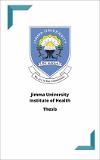IPHC-E Repository System
Technical efficiency of public health centers in three Woredas of Jimma Zone, Southwest Ethiopia
- Home
- →
- Universities
- →
- Jimma University, Institute of Health
- →
- JU Theses and Dissertations
- →
- View Item
JavaScript is disabled for your browser. Some features of this site may not work without it.
| dc.contributor.author | Tekle, Firew | |
| dc.date.accessioned | 2021-05-12T08:21:25Z | |
| dc.date.available | 2021-05-12T08:21:25Z | |
| dc.date.issued | 2015-06-30 | |
| dc.identifier.uri | http://repository.iifphc.org/handle/123456789/1300 | |
| dc.identifier.uri | https://repository.ju.edu.et/handle/123456789/2677 | |
| dc.description.abstract | Background: in low and middle income countries, which are where the vast majority of African countries are ranked, scarcity of funds for health is an acute problem. Health centers at the center of primary Health Care Unit (PHCU) are a vital part of Ethiopia’s public health system. Funds are being generously (75% of the total budget allocated to the health sector) provided for construction and running of health centers by the government, donors and international organizations. Therefore, scarce resources available to the health sector are compelling to question efficiency of health centers. Unless inefficiencies are identified and eliminated, resources will keep on leaking out of the health care system. Objectives: the objective of the study was to measure the magnitude of individual health center’s technical and scale efficiency. And estimate the amount of input reduction and/or output increases needed to make inefficient health centers efficient. Moreover, identifying factors associated to efficiency. Methods: This study used a two stage data envelopment method, to estimate the technical efficiency and factors associated with efficiency among 16 public health centers found in Kersa, Mana and Seka Chekorsa Woreda s of Jimma zone. Data envelopment analysis was used to estimate technical, scale efficiency of the health centers. Second stage analysis was conducted to identify institutional and environmental factors associated with efficiency using Tobit regression model. Results: Three out of the 16 health centers in the study were found to be technically efficient, with an average score of 77% (standard deviation = 16%). On the other hand, 8 out of 16 health centers were found to be scale efficient, with an average scale efficiency score of 94% (standard deviation = 9%). Catchment population and number of clinical staff were found to be directly associated with efficiency, while the number of nonclinical staff inversely was found to be associated with efficiency. Conclusion: The study has revealed that majority of the health centers are technical inefficient. Only half of the health centers were found to be scale efficient, implying that significant amounts of resources is being wasted. Considering the scarce resource available to the health sector, the findings indicate that performance improvement measures have to be taken to curb leakage of health care resources. | |
| dc.language.iso | English | |
| dc.publisher | Jimma University | |
| dc.subject | Health services | |
| dc.title | Technical efficiency of public health centers in three Woredas of Jimma Zone, Southwest Ethiopia | |
| dc.type | Thesis |
